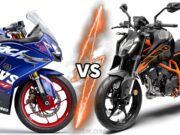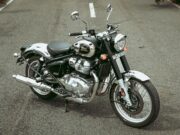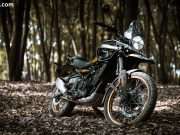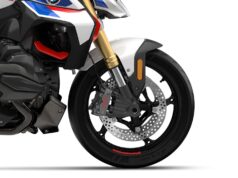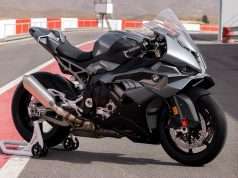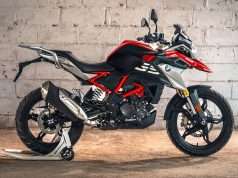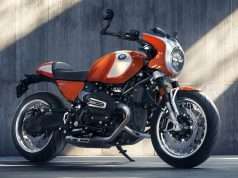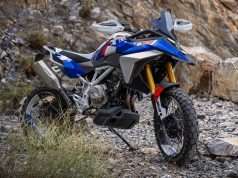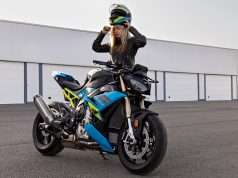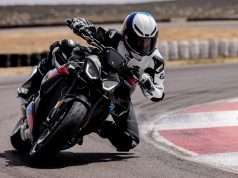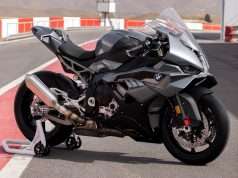
While everyone’s talking about the new C600 Sport and C650GT Maxi-Scooters from BMW Motorrad, we thought we’d take a moment to show you the beautiful R10 prototype scooter of the early 1950s. It nearly made it into serial production before the plug was pulled on the project by the Board in favor of the BMW Isetta car.
Completely developed by BMW, this scooter prototype was conceived at the beginning of the Fifties, which coincided with a booming interest in low-cost, two-wheeled transportation in the post-war years. The first design sketches appeared in December 1950 and show a scooter with large wheels similar in size to those found on a motorcycle. In those days the company didn’t have a separate design department — the first dedicated BMW motorcycle designers only started with the development of the iconic R90S boxer in the early 1970s — so a talented engineer or technician with a ‘good feeling for the form’ would previously have had the responsibility of penning the early sketches.
There were no clay models at this time either, although some made from plasticine and wood were created to show the R10’s potential to compete against the mighty Italian scooter brands of the time. A 198cc single-cylinder engine was especially developed for this machine and a revised 175cc version then found its way into a later prototype. With swooping, all-enclosing bodywork, smaller wheels, wide handlebars and enough room for two, could the R10 compete against the class-leading, smaller-engined Vespas and Lambrettas buzzing around the congested cities of Europe?
It is a question to which we’ll never know the answer, as the scooter market began to show signs of slowing down in 1954 and BMW management took the decision to stop the project immediately. The company needed the cash flow that could be derived from volume sales of a mass-produced, value-for-the-money vehicle, and having secured the production rights for an unconventional, yet innovative two-seater bubble car originally made by Italian company Iso, the inexpensive BMW Isetta vehicle was launched in April 1955. It turned out to be the right decision for the company as the little Isetta was a big success, selling more than 160,000 units by the time production ceased in 1962. Selling anywhere near that volume of scooters would have been near impossible, given the fact that there was no obvious market for them in Germany and it would have been difficult to export them successfully to the largest potential market in Italy, considering the competition that already existed there.
Alas, the R10 with its protruding horn and light unit in the front fairing, and spare wheel carried on the rear, was consigned to history. It had been so close to serial production but, according to BMW Group Classic historian Fred Jakobs, it was a simple business decision that turned out to be the correct one for the company.
“At the time the R10 scooter was ready for production, the Board had a difficult decision to make,” he said. “BMW was even back then a company known for its premium products and after many internal discussions it was decided that the scooter just wasn’t special enough, either in terms of its product offering or its features when compared to the competition. The timing was also against it of course, because just when the scooter was due to enter its production phase, this coincided with a crisis in the motorcycle industry, which no doubt helped spur the decision to go ahead with production of the Isetta.”

Now, there are just two of these wonderful R10 scooters in existence — both safely kept in the BMW Group Classic collection in Munich. One of them is a working prototype and the other, which doesn’t have an engine, is kept just for display purposes. The R10 will be making a public appearance on May 25-27 at the Concorso d’Eleganza Villa d’Este at Lake Como in Italy. It is Europe’s most prestigious classic automotive gathering where magnificent vehicles from the glory years of the last century are displayed in a setting befitting their beauty and technical innovation. For the first time in 2011, motorcycles were included in this famous automotive festival and BMW was well represented in the Design Prototype Exhibition, where the stunning 1934 Art Deco-inspired R7 was placed alongside other machines from the BMW Group, including the concept Husqvarna Mille 3 and the 2009 Concept 6 — the forerunner study to the six-cylinder K1600GT and GTL luxury touring machines.

Interestingly, the R7’s potential high cost made it uneconomic to put into series production in the 1930s and just like the R10 scooter some two decades later, it was quietly put away where it would lie undisturbed for many years. With the arrival of the new C600 and C650 GT Maxi-Scooters, the time is now right to revisit this early example of BMW scooter design from nearly 60 years ago, which will no doubt attract crowds of passionate Italian admirers throughout the weekend at the Concorso d’Eleganza Villa d’Este.










